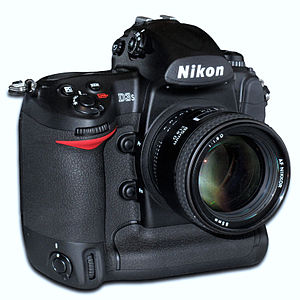 | |
| Overview | |
|---|---|
| Type | Digital single-lens reflex camera |
| Released | 14 October 2009 |
| Lens | |
| Lens | Interchangeable, Nikon F-mount |
| Sensor/medium | |
| Sensor | 36.0 mm × 23.9 mm CMOS, Nikon FX format|DX format |
| Sensor maker | Nikon[1] |
| Maximum resolution | 12.1 effective megapixels (4,256 × 2,832 pixels) |
| Film speed | ISO equivalency 200 to 12800 in 1/3, 1/2 or 1.0 EV steps, Boost: 100–102400 in 1/3, 1/2 or 1.0 EV steps |
| Storage media | Two CompactFlash (Type I) card slots |
| Focusing | |
| Focus modes | Single-servo AF (S), Continuous-servo AF (C), Manual |
| Focus areas | 51-area Nikon Multi-CAM 3500FX |
| Focus bracketing | none |
| Exposure/metering | |
| Exposure modes | Programmed Auto [P], Shutter-Priority Auto [S], Aperture-Priority Auto [A], Manual [M] |
| Exposure metering | TTL full aperture exposure metering system |
| Metering modes | 1,005-pixel RGB 3D Color Matrix Metering II, Variable Center-Weighted, Spot AF |
| Flash | |
| Flash | n/a |
| Flash bracketing | 2-9 frames in steps of 1/3, 1/2, 2/3 or 1 EV |
| Shutter | |
| Shutter | Electronically controlled vertical-travel focal-plane shutter |
| Shutter speed range | 30 to 1/8000 second and bulb |
| Continuous shooting | 9 frame/s (11 frame/s in DX crop mode) |
| Viewfinder | |
| Viewfinder | Optical-type fixed eye level pentaprism |
| Image processing | |
| White balance | Auto, Presets (5), Manual, and Color temperature in kelvins |
| WB bracketing | 2 to 9 frames, 10,20,30 MIRED steps |
| General | |
| LCD screen | 3-inch diagonal, 307,000 pixels (920,000 dots), TFT VGA |
| Battery | Li-ion EN-EL4a |
| Optional battery packs | EH-6 AC Adapter |
| Weight | 1,240 g (2.73 lb) |
| Made in | |
| Chronology | |
| Predecessor | Nikon D3 |
| Successor | Nikon D4 |
The Nikon D3S is a 12.1-megapixel professional-grade full frame (35mm) digital single-lens reflex camera (DSLR) announced by Nikon Corporation on 14 October 2009.[2] The D3S is the fourth camera in Nikon's line to feature a full-frame sensor, following the D3, D700 and D3X. It is also Nikon's first full-frame camera to feature HD (720p/30) video recording. While it retains the same number of pixels as its predecessor, the imaging sensor has been completely redesigned.[2] Nikon claims improved ultra-high image sensor sensitivity with up to ISO 102400,[3] HD movie capability for extremely low-lit situations,[4][5] image sensor cleaning, optimized workflow speed, improved autofocus and metering, enhanced built-in RAW processor, quiet shutter-release mode, up to 4,200 frames per battery charge and other changes compared with the D3.[2] It was replaced by the D4 as Nikon's high speed flagship DSLR.
- ^ Full Frame DSLR Cameras Part I - Nikon vs Sony Archived 2019-05-21 at the Wayback Machine Chipworks
- ^ a b c "Digital SLR Camera Nikon D3S". Nikon Corporation. October 14, 2009. Retrieved December 16, 2009.
- ^ "Nikon D3S Sample Images". Nikon Corporation. Archived from the original on 2010-11-04. Retrieved December 16, 2009.
- ^ Melanson, Donald (October 14, 2009). "Nikon D3S shows its high ISO prowess in two sample videos". Engadget. Retrieved October 16, 2009.
- ^ "NIKON D3S TEST". Scanout.com. October 13, 2009. Retrieved December 16, 2009.[dead YouTube link]